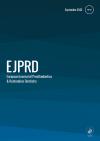European Journal of Prosthodontics and Restorative Dentistry
Evaluation of Various Polishing Systems for Lithium Disilicate Glass-Ceramics
Abstract
Objective: The aim of this study was to investigate the surface roughness of lithium disilicates (LS2s) polished using various polishing systems. Materials and Methods: Two types of LS2 (A, Amber Mill and E, IPS e.max CAD) were polished using LS2-specific polishing systems (L-Edenta, L-Jota), a zirconia-specific polishing system (Z-Jota), and a conventional ceramic polishing system (P-Shofu) (n = 8 per group). The compositions of different polishing systems were analyzed using EDS. Surface roughness was measured using confocal laser scanning microscopy and analyzed using EDS and SEM. ANOVA and
Tukey’s tests were used for the statistical analyses (p = 0.05). Results: The polishing systems were mainly composed of C, O, and Si. The L-Jota group exhibited rougher surfaces than the other groups. Amber Mill exhibited higher surface roughness than IPS e.max CAD (p<0.001). Among the polishing systems, the L-Jota group presented the highest roughness value (p<0.001). The surface roughness of the AL-Jota group was higher than that of the other groups. Conclusions: A sufficiently smooth surface can be achieved without a LS2-specific polishing system. Further, the same polishing system can have different effects depending on the type of LS2.
Keywords
Surface Roughness
Lithium Disilicate
Confocal Microscope
Polishing Systems
Element Compositions
Authors
Ye-Jin Lee, Yoon-Hyuk Huh, Kyung-Ho Ko, Chan-Jin Park, Lee-Ra Cho
Articles from this issue
 Free Access
Free Access No Access
No Access Full Access
Full Access


